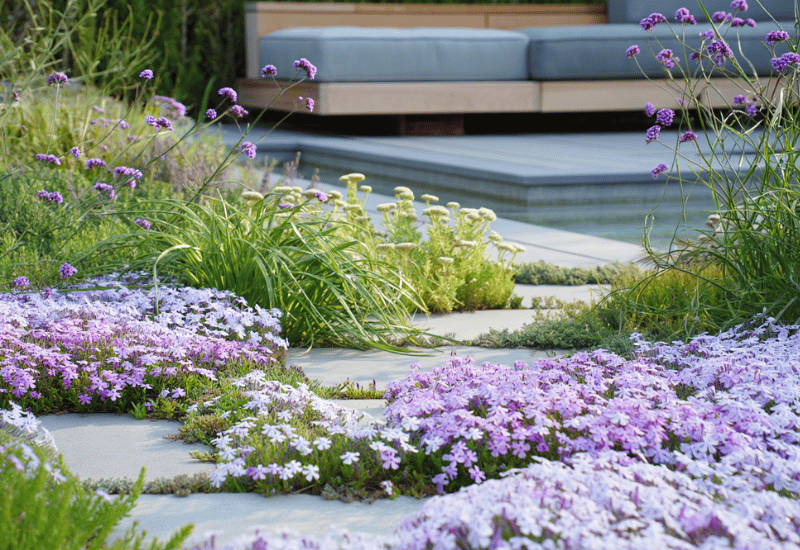
If you’ve spent any time in your garden, you know the frustration—those stubborn weeds just won’t quit. You pull them out, and before you know it, they’re back. You try mulch, maybe even sprays, but honestly… most of those things only do so much, and some can even do more harm than good.
It can feel like a battle you’ll never win.
But what if there was a smarter way—one that didn’t involve constant weeding or harsh chemicals? That’s where ground covers come in.
Ground covers are low-growing plants that spread across the soil like a living carpet. They’re not just easy on the eyes—they work hard. They shade the soil, keep it from drying out, and, best of all, they block weeds from taking root.
Some bloom with delicate flowers, adding life and color. Others stay lush and green year-round. Either way, they fill those empty spaces where weeds usually pop up—whether it’s a sunny patch, a shady corner, or a spot where grass refuses to grow.
If you’re ready to finally give weeds a run for their money, here are 11 ground covers that will do exactly that—without asking for much in return.
1: Lady’s Mantle (Alchemilla mollis)

Lady’s mantle isn’t the kind of ground cover that races across a bed overnight, but that’s exactly why I like it. It spreads at a steady pace, clump by clump, and before long those soft, scalloped leaves start overlapping to shade the soil. Weeds just don’t stand much of a chance underneath. Over time, the clumps knit together into a natural carpet that keeps things neat without ever feeling out of control.
The flowers are an extra treat. In late spring, it sends up billowy sprays of chartreuse blooms that look like a mist floating above the foliage. They aren’t loud or flashy, but they do something special—soften the edges of borders, brighten gravel paths, and tie mixed plantings together. I’ve found it especially handy along stone walls where weeds sneak in; lady’s mantle just fills the cracks and holds its ground. Divide it every few years and you’ll have even more to spread around, all with the same reliable weed-suppressing habit.
· Hardiness: USDA zones 3 to 8
· Light exposure: full sun to partial shade; best with some afternoon shade in hotter areas
· Flowering season: late spring to early summer
· Size: 12 to 18 inches tall (30–45 cm), spreading 18 to 24 inches (45–60 cm) as clumps slowly widen
· Soil and water requirements: average, moderately fertile, well-drained soil; enjoys steady moisture but tolerates short dry spells once established
2: Creeping Mazus (Mazus reptans)

Few ground covers settle in as quickly as creeping mazus. Give it a little moisture and it races out on wiry stems, rooting wherever they touch the soil, until the ground is sealed under a mat of tiny leaves. Once it fills in, weeds can’t find daylight, and even between stepping-stones or flagstone paths, the cover holds tight. Step on it and it bounces back—one of the reasons gardeners often use it as a lawn substitute in small, shady patches.
In late spring, it surprises you with a scattering of violet-blue flowers, each with a yellow throat like a miniature orchid. The bloom is brief, but cheerful, and the foliage does the real work the rest of the year, staying green through most winters in milder zones. Creeping mazus doesn’t bully its neighbors, but it’s steady—expand it by division if you want, or just let it knit on its own until the weeds have nowhere left to go.
· Hardiness: USDA zones 4 to 9.
· Light exposure: full sun to partial shade.
· Flowering season: late spring to early summer.
· Size: 2 to 3 inches tall (5 to 8 cm) and 12 inches or more in spread (30+ cm), expanding rapidly by creeping stems.
· Soil and water requirements: prefers moist, well-drained soil; tolerates average garden soil and short dry spells once established.
3: Creeping Thyme (Thymus serpyllum)
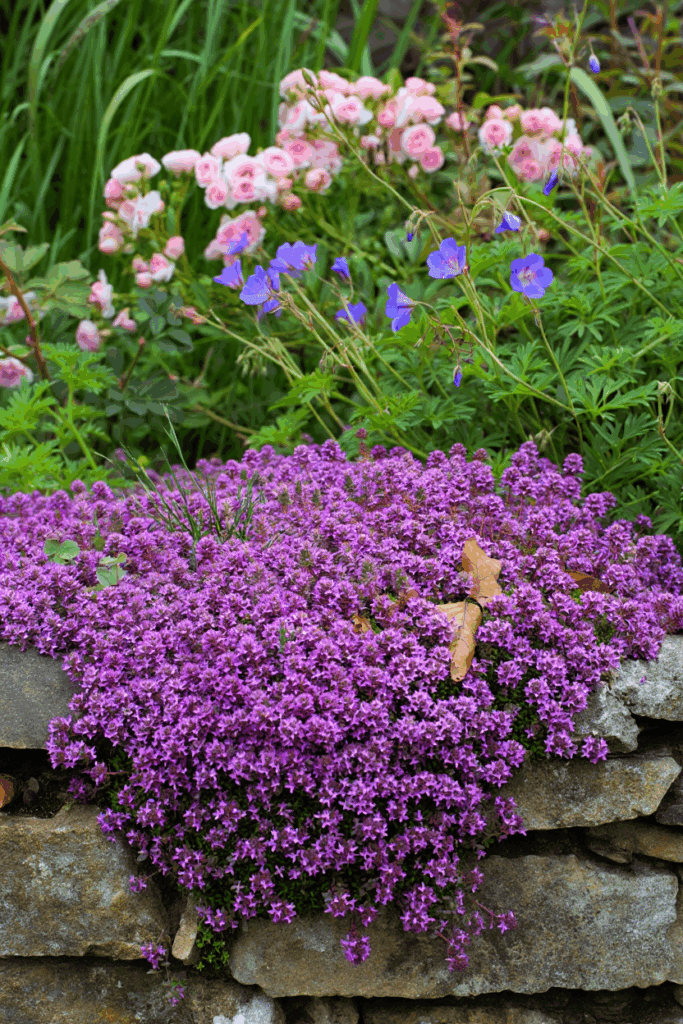
Botanically speaking, creeping thyme is a woody-based subshrub with prostrate stems that root where they contact soil, gradually forming mats. Growth can extend several inches outward per year, and because the foliage is tightly imbricate (overlapping), it creates an almost continuous ground seal. That canopy effect denies weeds the light and space they need, acting as a living mulch in sunny beds. Its small, opposite leaves are rich in aromatic oils—brushing them releases thymol, the compound that gives thyme its scent.
In early to midsummer, creeping thyme shifts from subtle to spectacular. Each stem tip carries verticillasters (whorled clusters) of tiny pink to purple flowers, rich in nectar and highly attractive to pollinators. The low habit (rarely more than 4 inches tall) makes it perfect between stones, along walkways, or as a lawn alternative in dry, poor soils. Once established, it thrives in conditions that defeat fussier ground covers—heat, drought, and lean, rocky soils.
· Hardiness: USDA zones 4 to 9
· Light exposure: full sun
· Flowering season: early to mid-summer
· Size: 2–4 inches tall (5–10 cm), spreading 1–2 feet (30–60 cm) via creeping, rooting stems
· Soil and water requirements: prefers sandy, well-drained soils; drought tolerant and thrives in nutrient-poor ground
4: Irish Moss (Sagina subulata)
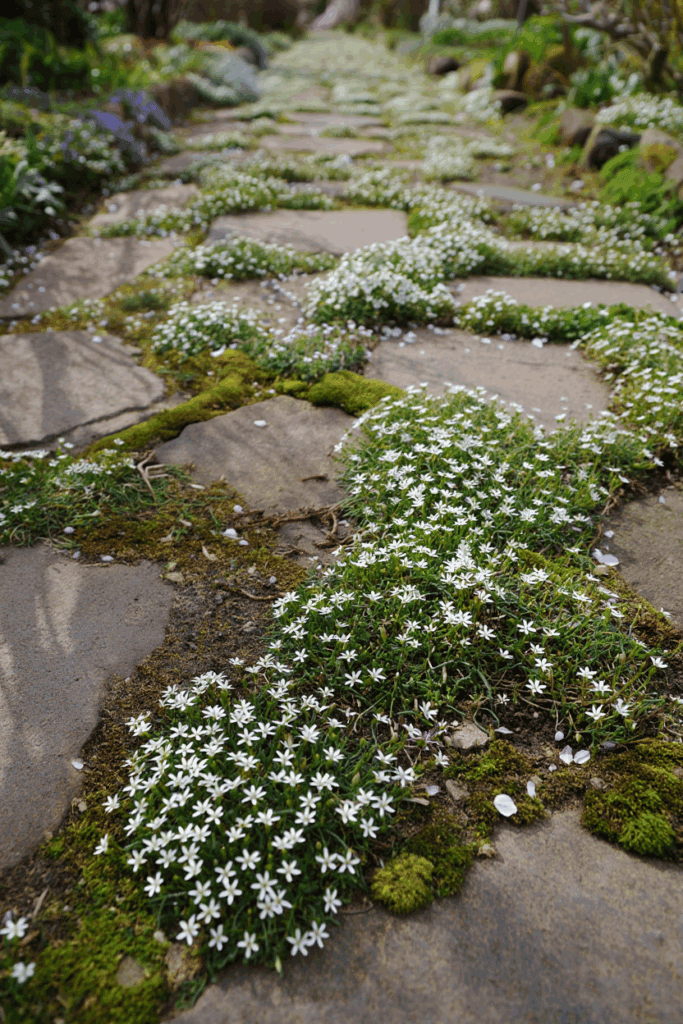
If weeds keep popping up in the cracks of your path or patio, Irish moss is one of the easiest fixes. This little perennial creeps in by slender, branching stems that root along the way, weaving together until the gaps are sealed tight. Once it settles, the dense mat shades the soil so weed seeds can’t germinate—no more stooping to pull dandelions or chickweed from between stones. The effect is soft and mosslike, though it’s actually in the carnation family (Caryophyllaceae), not a true moss.
In late spring, the green cushion transforms with a sprinkling of tiny white flowers, each star-shaped and no more than a half inch across, dotting the mat like fallen snow. The foliage itself is made of slender, awl-shaped leaves (hence the Latin subulata, “awl-shaped”), which stay bright green and neat throughout the year in most climates. While it spreads slowly compared to aggressive ground covers, Irish moss excels in tight spaces—paving seams, rock gardens, or small shady beds—where its steady growth keeps weeds from ever finding a foothold.
· Hardiness: USDA zones 4 to 8
· Light exposure: full sun to partial shade
· Flowering season: late spring into summer
· Size: 1 to 2 inches tall (2–5 cm), spreading 12 inches (30 cm) or more over time
· Soil and water requirements: prefers evenly moist, well-drained soil; needs regular water in hot summers but resents soggy ground
5: Carex (Sedges)
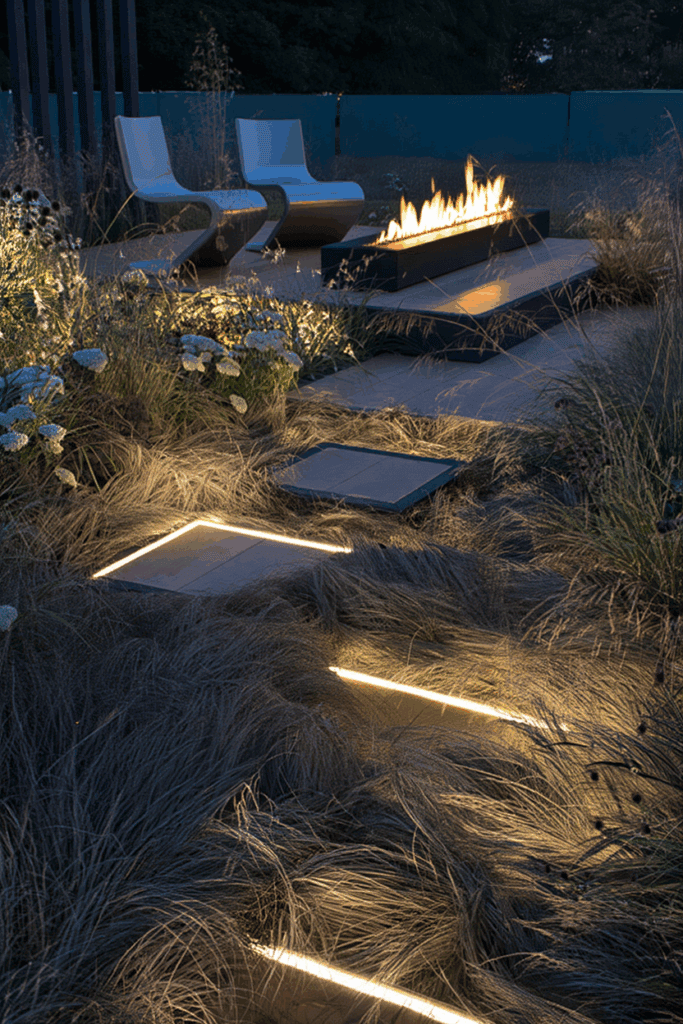
Carex doesn’t grab attention with showy flowers, but as a weed-stopping ground cover, it earns its place. Many sedges spread by short rhizomes, creeping outward to form tight colonies of grass-like leaves. Once those colonies link up, they shade the soil so completely that weeds have a hard time breaking through. I’ve seen Pennsylvania sedge (Carex pensylvanica) take over under oaks where grass simply gave up—within two years the bare patches were gone, replaced by a soft, even carpet.
Different species give you different looks. Some are upright and arching, others low and flowing, but all create steady cover that holds its ground through the seasons. Many are semi-evergreen, so the soil never lies exposed, even in winter. They aren’t flashy, but they’re practical: plant them once, let them spread, and you’ll spend a lot less time pulling weeds.
· Hardiness: USDA zones 4 to 9 (varies by species).
· Light exposure: thrives in partial shade; some species prefer full sun, others tolerate deep shade.
· Flowering season: late spring to early summer, with small, grass-like blooms.
· Size: generally 6 to 12 inches tall (15 to 30 cm) and 12 to 18 inches in spread (30 to 45 cm), expanding gradually by rhizomes.
· Soil and water requirements: prefers moist, well-drained soil; some species tolerate dry shade or sandy ground once established.
6: Woolly Yarrow (Achillea tomentosa)
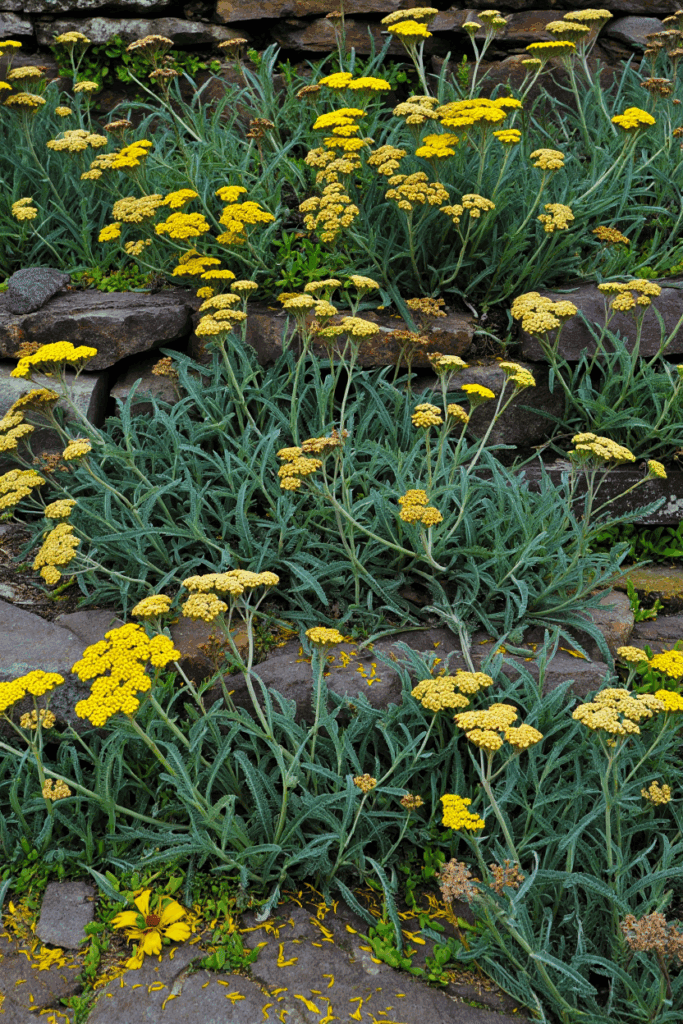
If you’ve ever wished weeds would just give up on that sunny, dry patch of soil, woolly yarrow might be the plant to do it for you. Unlike its taller meadow cousins, this species stays low and spreads by short rhizomes, creeping outward until the soil is covered in a silvery-green mat. The leaves are small, finely divided, and covered in tiny hairs (that’s what gives them their soft, woolly look). Once that dense foliage closes in, it shades the soil so completely that weed seedlings rarely make it through.
Come summer, the silver carpet pops with bright yellow flower heads—technically flat-topped corymbs made up of dozens of tiny composite florets. Pollinators flock to them, and the contrast against the fuzzy foliage is striking. The best part is that woolly yarrow doesn’t sprawl like common yarrow (Achillea millefolium). It keeps a compact, well-behaved shape, making it ideal for rock gardens, sunny slopes, or borders where you want color and cover without constant weeding.
· Hardiness: USDA zones 3 to 8
· Light exposure: full sun
· Flowering season: early to mid-summer
· Size: 6–12 inches tall (15–30 cm) and 12–18 inches wide (30–45 cm), spreading gradually by rhizomes
· Soil and water requirements: thrives in sandy, gravelly, or poor soils; very drought tolerant once established, but resents heavy, wet ground
7: Sapphire Indigo Clematis (Clematis ‘Sapphire Indigo’)
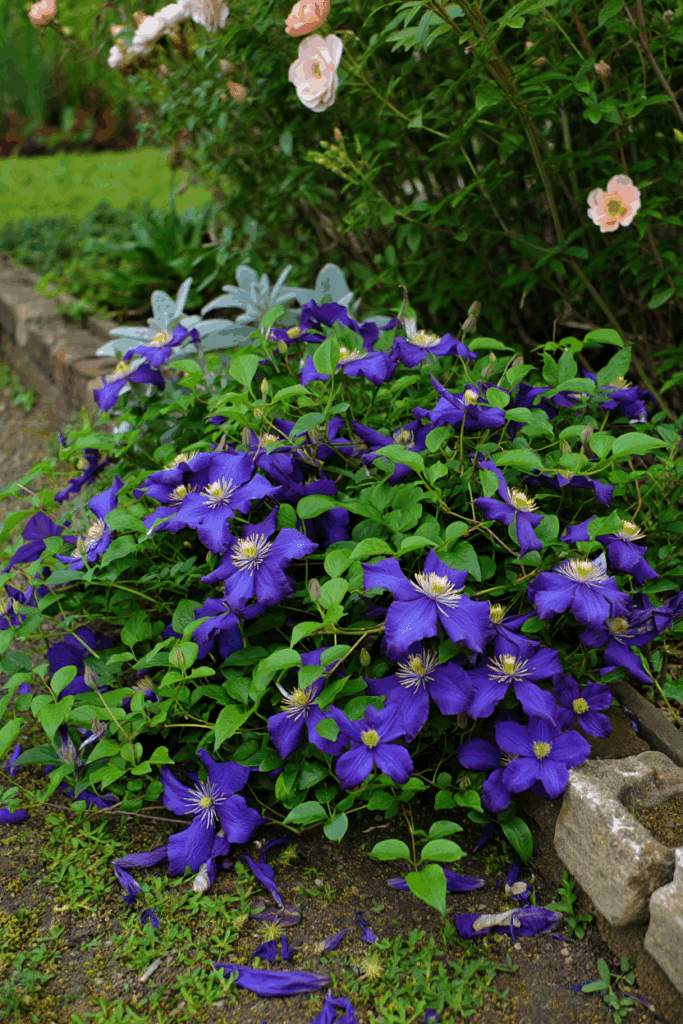
Most clematis want to climb, but not this one. Clematis ‘Sapphire Indigo’ is semi-herbaceous and non-vining—it doesn’t twine or cling. Instead, the stems sprawl outward and arch, rooting lightly as they touch the soil. Over time, those stems knit together into a dense, leafy cover that blankets bare ground and blocks weeds from sprouting. Think of it as a clematis that behaves like a low perennial rather than a vine—you get the flowers without the trellis.
And the flowers are what make this plant shine. From late spring straight into fall, it produces an almost continuous flush of blooms—velvety violet-blue tepals surrounding a cluster of bright yellow stamens. Because it’s remontant (repeat-blooming), the display overlaps with summer perennials, filling gaps and preventing weeds from sneaking in. The foliage, dark green and leathery, stays full and neat even under heavy bloom. Used on slopes, in wide borders, or spilling over walls, it forms a colorful mat that does double duty: weed control and nonstop flower power.
· Hardiness: USDA zones 4 to 9
· Light exposure: full sun to partial shade; needs at least 6 hours of sun for best flowering
· Flowering season: late spring through early fall (repeat-blooming)
· Size: 18–24 inches tall (45–60 cm) and up to 4 feet wide (1.2 m)
· Soil and water requirements: fertile, well-drained soil with medium moisture; roots prefer cool soil—mulch helps keep them shaded and moist
8: Heath Aster (Symphyotrichum ericoides)
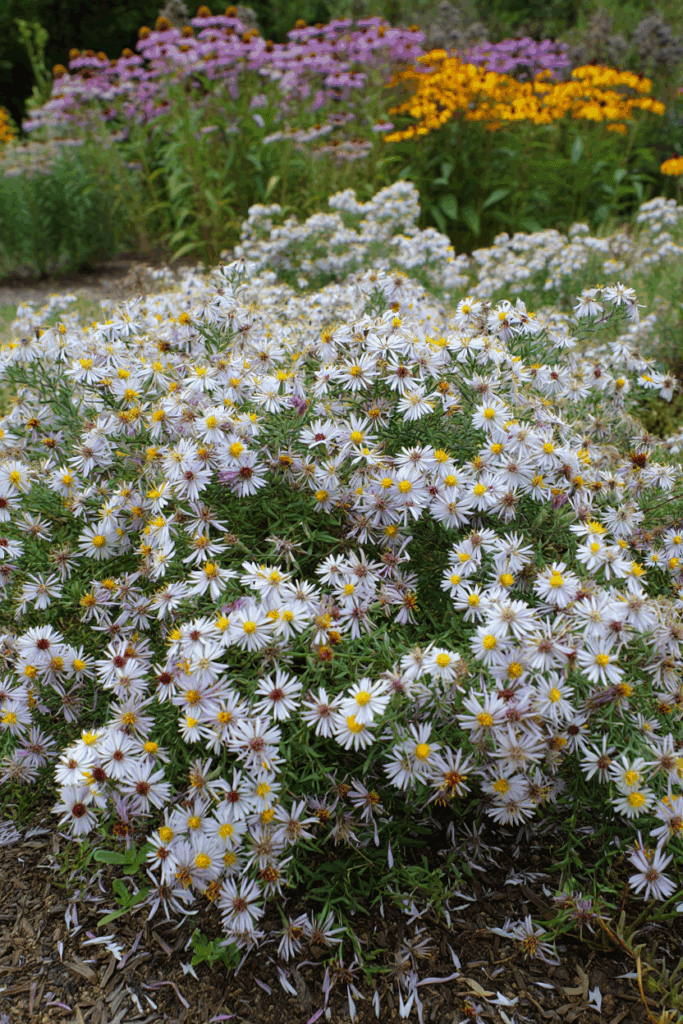
Don’t let its delicate flowers fool you—heath aster is one of the toughest ground covers you can plant. This North American native spreads underground by rhizomes, sending up shoots that quickly knit into dense colonies. Once the foliage fills in, it shades the soil and makes life nearly impossible for weed seedlings. In fact, the basal leaves stay so tight to the ground that they act like living mulch, locking out light and sealing in moisture. I’ve watched it take over rough, weedy ground behind a shed and turn it into a solid, weed-free stand within just a few seasons.
The reward comes in fall, when each stem erupts with dozens of tiny, white, daisy-like flowers (composite inflorescences, typical of the Asteraceae family). From a distance, the colony looks as though it’s been dusted with snow, and bees and butterflies pile in for the late-season nectar. It does spread with enthusiasm, so heath aster is best planted where it has room to run—on slopes, along a border edge, or in naturalized drifts where its vigor is a blessing rather than a chore.
· Hardiness: USDA zones 3 to 9
· Light exposure: full sun
· Flowering season: late summer to fall
· Size: 1–3 feet tall (30–90 cm), spreading widely by rhizomes to form colonies
· Soil and water requirements: adaptable; thrives in average to poor soils, tolerates clay, and is drought resistant once established
9: Sweet Woodruff (Galium odoratum)

If you’ve got a shady corner where weeds always win, sweet woodruff is one of the easiest ways to flip the balance. It spreads by underground rhizomes, sending up stems ringed with star-shaped leaves that knit together into a solid cover. Once it fills in, the mat is tight enough that very little light reaches the soil—weed seeds simply don’t stand a chance. I’ve planted it under maples where even ground ivy struggled, and within a couple of years the patch was nothing but clean, green woodruff.
Botanically, it belongs to the coffee family (Rubiaceae), and you can see the family resemblance in its whorled leaf pattern and tiny, cross-shaped flowers. In mid-spring, those flowers open in loose clusters, bright white against the green, and carry a subtle sweetness. Crush the leaves and you’ll notice a haylike scent—caused by coumarin—that lingers when the foliage is dried. That’s why it was once stuffed into pillows, sachets, and even May wine. In the garden though, its real gift is simpler: it does the weed control for you in places where few other covers succeed.
· Hardiness: USDA zones 4 to 8
· Light exposure: partial to full shade; tolerates morning sun if kept moist
· Flowering season: mid- to late spring
· Size: 6–8 inches tall (15–20 cm) and 12–18 inches wide (30–45 cm), spreading steadily by rhizomes
· Soil and water requirements: prefers moist, humus-rich, well-drained soil; tolerates average garden soil but thrives with consistent moisture
10: Bugleweed (Ajuga reptans)
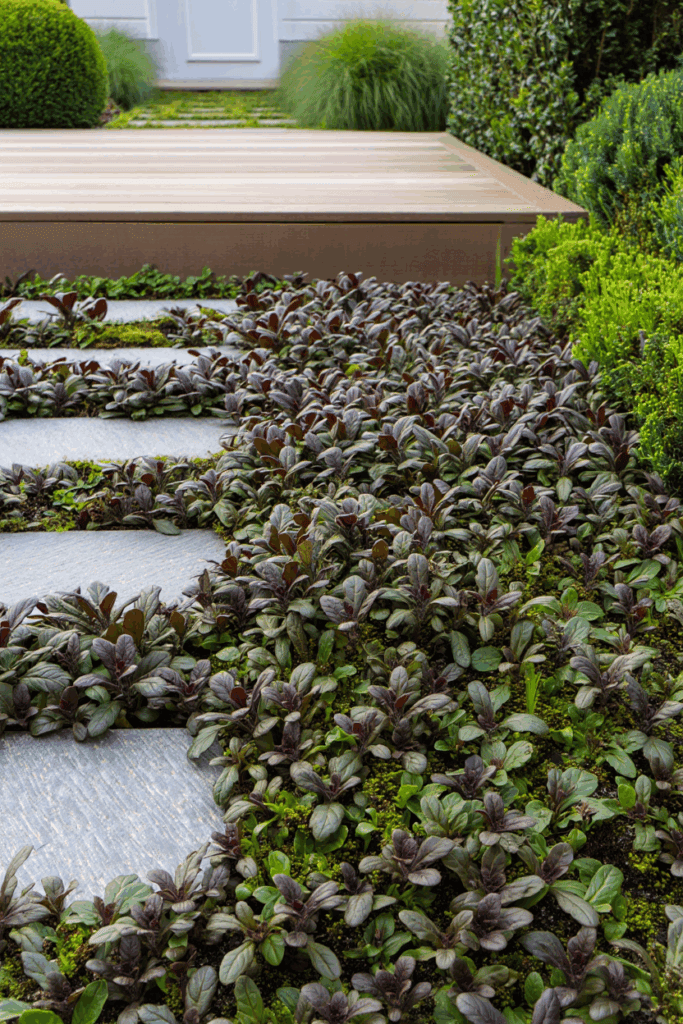
If you need a ground cover that spreads fast and doesn’t give weeds a chance, bugleweed is one of the toughest options. It creeps by stolons, sending out runners that root as they go, quickly knitting into dense mats of foliage. Once it’s established, bare soil disappears under overlapping leaves, and weeds simply can’t break through. I’ve seen it cover a bed in one season where other plants took years, which makes it a go-to for problem spots.
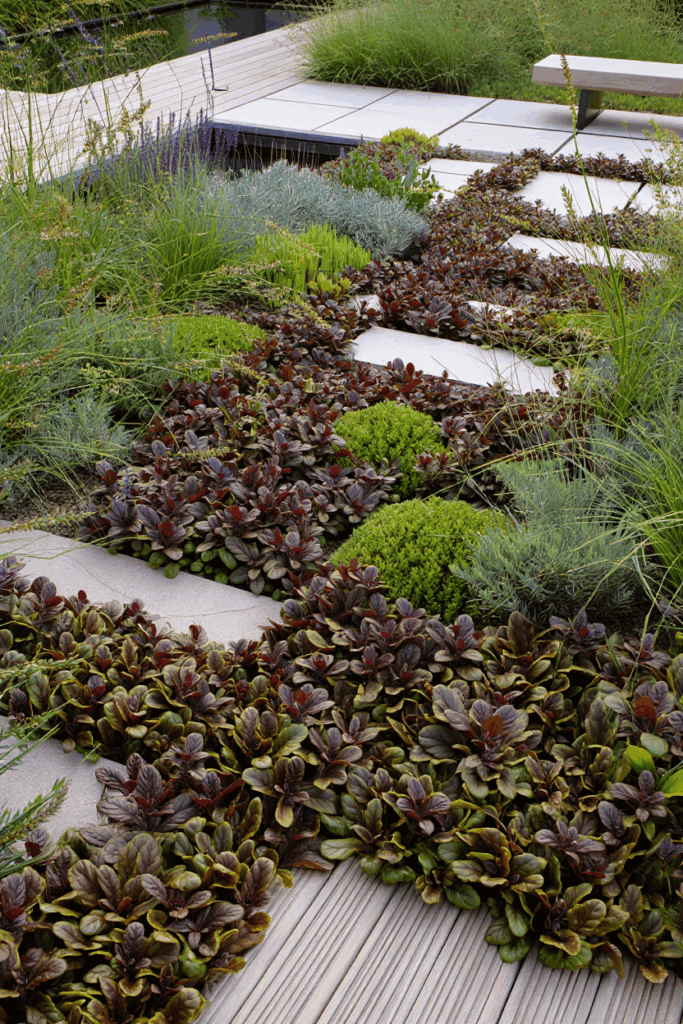
Bugleweed isn’t just functional—it’s colorful. Leaves can be glossy green, bronze, or variegated depending on the variety, and in spring it pushes up short spikes of blue-violet flowers that bees adore. Cultivars like ‘Chocolate Chip’ stay low and compact, while ‘Burgundy Glow’ adds splashes of cream and pink to the foliage. It does spread aggressively, so it’s best for large areas, slopes, or places where you truly want weeds choked out. A quick trim after flowering keeps it tidy and prevents it from seeding around.
· Hardiness: USDA zones 3 to 9.
· Light exposure: full sun to partial shade (best color in sun, best spread in shade).
· Flowering season: mid- to late spring.
· Size: 4 to 8 inches tall (10 to 20 cm) and up to 2 feet in spread (60 cm), expanding fast by runners.
· Soil and water requirements: average, moist, well-drained soil preferred; tolerates clay or poor soil. Moderately drought tolerant once established.
11: Foamflower (Tiarella cordifolia)
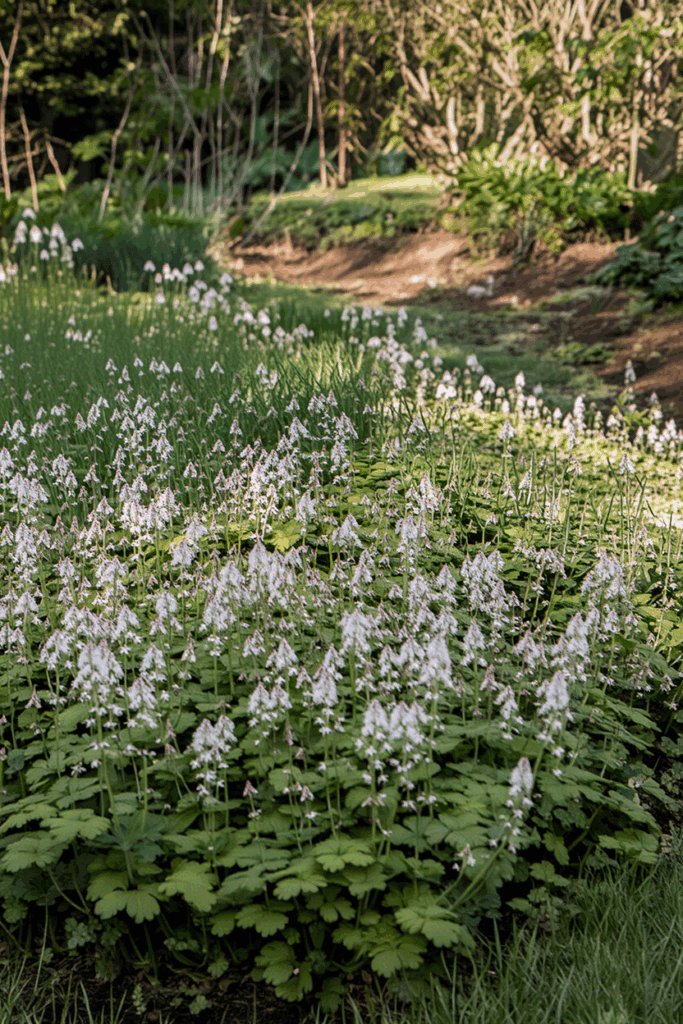
Foamflower is one of the best choices for weed control in shade. Unlike many ground covers that struggle without sun, it spreads steadily by stolons in cool, damp conditions, forming colonies of heart-shaped leaves that link together and block weeds from sprouting. Once the clumps meet, the ground stays covered year-round with dense, semi-evergreen foliage. I’ve used it under trees where grass never grew, and within a few seasons the weeds were gone, replaced by a soft, leafy carpet.
In spring, foamflower lives up to its name, sending up sprays of frothy white flowers that float above the foliage like delicate lace. The blooms are short but striking, and even when they fade, the patterned leaves keep the planting attractive. Cultivars like ‘Running Tapestry’ offer especially strong stolon growth, making them ideal for covering larger shaded areas without leaving gaps for weeds.
· Hardiness: USDA zones 4 to 9.
· Light exposure: partial to full shade.
· Flowering season: mid- to late spring.
· Size: 6 to 12 inches tall (15 to 30 cm) and 12 to 24 inches in spread (30 to 60 cm), expanding steadily by stolons.
· Soil and water requirements: humus-rich, moist, well-drained soil; benefits from consistent moisture, though it tolerates average garden soil once established.
12: Creeping Juniper (Juniperus horizontalis)

Creeping juniper is one of the most dependable evergreen ground covers for smothering weeds and holding slopes. It spreads low and wide, rooting along its stems as it goes, until it forms a dense, woody mat that weeds simply can’t break through. Once established, it’s practically maintenance-free—no mowing, no watering beyond the first season, and no bare soil left exposed. I’ve seen it cover a bank where grass failed, and within a few years it had locked the soil in place and shut out every weed.
The foliage is soft and feathery, ranging in color from silvery-blue to deep green depending on the cultivar. In winter, many varieties take on bronze or purple tints, adding seasonal interest while still keeping the ground covered. Popular picks include ‘Blue Rug’, which hugs the ground tightly, and ‘Prince of Wales’, which spreads rapidly for large-scale coverage. Whether you plant it to control erosion, edge a large bed, or just to cut down on weeding, creeping juniper gets the job done.
· Hardiness: USDA zones 3 to 9.
· Light exposure: full sun for best color and spread.
· Size: 6 to 12 inches tall (15 to 30 cm) and 6 to 8 feet in spread (1.8 to 2.4 m), expanding steadily by rooting stems.
· Soil and water requirements: thrives in poor, sandy, or rocky soils with sharp drainage; drought tolerant once established.
13: Lamb’s Ear (Stachys byzantina)
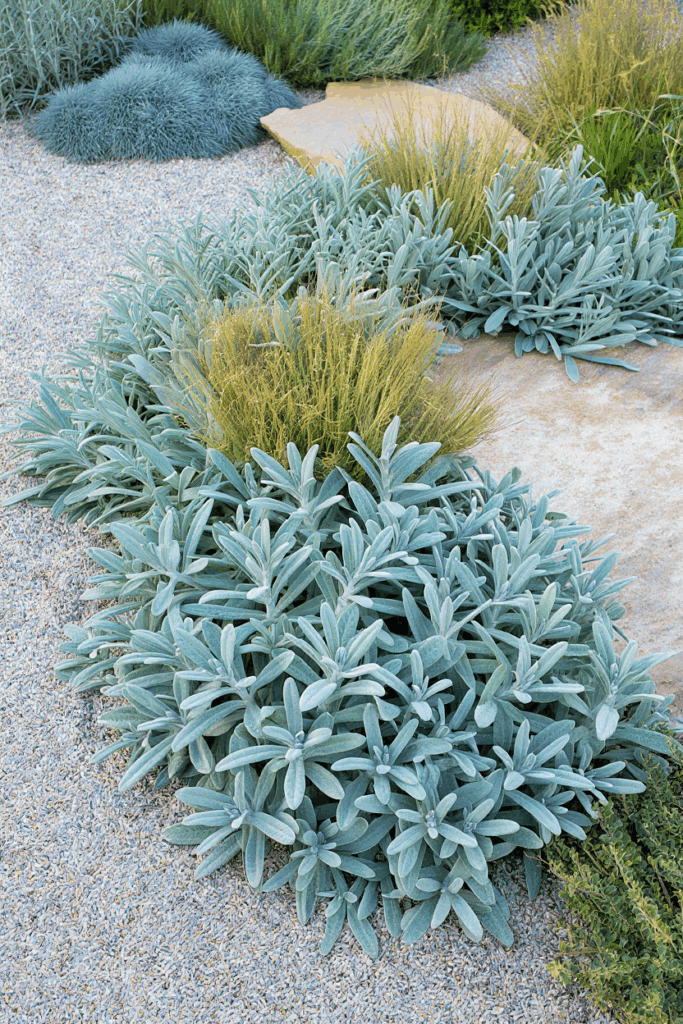
If you’ve ever had a dry, sunny corner of the garden where weeds seem to pop up no matter what you do, lamb’s ear might be your answer. It spreads low and wide, those soft silver leaves overlapping until there’s simply no space left for weeds to sneak in. Once it takes hold, it acts like a built-in mulch—keeping the soil cool, holding in a bit of moisture, and shutting down weed seedlings before they even start.
And honestly, it’s just plain fun to grow. The foliage feels like velvet, and kids (and plenty of adults) can’t resist touching it. In early summer, you may see tall fuzzy stalks tipped with purple flowers. You can leave them for the bees or cut them back if you prefer to keep the look tidy—it’s completely up to you. I like using lamb’s ear to edge a path or soften the front of a border; it always manages to look intentional while doing the behind-the-scenes work of weed control.
· Hardiness: USDA zones 4 to 8
· Light exposure: full sun to light shade
· Flowering season: late spring into summer (if flower stalks are left)
· Size: 4 to 8 inches tall (10–20 cm) for foliage; up to 18 inches (45 cm) when in bloom; spreads 18 to 24 inches (45–60 cm)
· Soil and water requirements: thrives in poor, well-drained soils; drought tolerant once established but dislikes soggy conditions
14: Ice Plant (Delosperma cooperi)

If you’ve got a hot, dry spot where nothing seems to grow, ice plant might surprise you. This succulent hugs the ground on trailing stems, rooting as it spreads and building a tight carpet of fleshy leaves that weeds simply can’t push through. Look closely at those little leaves on a sunny day—you’ll notice the sparkling cells that give the plant its name, almost as if they’ve been dusted with frost.
Then comes the color. All summer long, ice plant bursts into bloom with hundreds of daisy-like flowers in vivid shades of magenta, yellow, or orange, depending on the variety. They open in the heat of the day, when most plants are wilting, and pollinators love them. Once established, the mat takes care of itself—no watering, no fuss—and weeds are left with no room to gain a foothold. It’s the kind of ground cover that does the heavy lifting while still looking like a garden showpiece.
· Hardiness: USDA zones 5 to 9 (varies by species)
· Light exposure: full sun
· Flowering season: late spring through summer, with repeat bloom in warm climates
· Size: 3–6 inches tall (8–15 cm), spreading 18–24 inches (45–60 cm) by trailing stems
· Soil and water requirements: thrives in sandy, gravelly, well-drained soil; drought tolerant; dislikes heavy or soggy ground
15: Rock Cress (Aubrieta deltoidea)
Rock cress is a classic alpine perennial, well adapted to thin, stony soils where weeds usually get the upper hand. Belonging to the mustard family (Brassicaceae), it spreads in low cushions by short stolons and tight clumping stems, creating a dense mat that excludes light from the soil surface. Once established, this mat structure makes it very difficult for weed seedlings to germinate or compete for space.
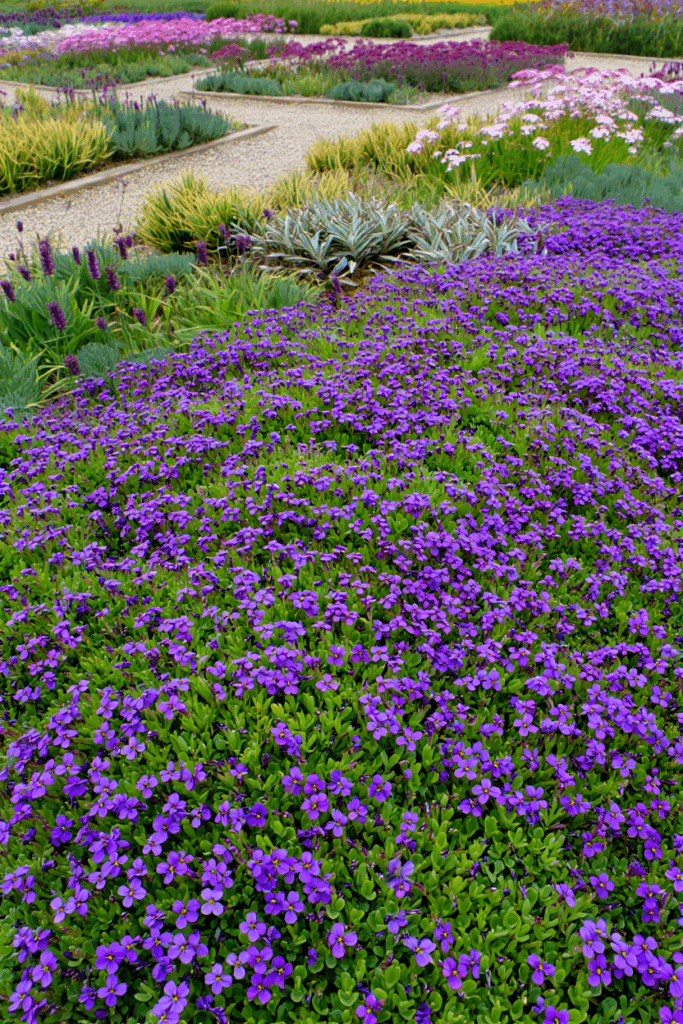
The foliage is small, ovate to deltoid (hence the species name deltoidea), often with a slightly gray-green cast from fine hairs that reduce water loss. In early to mid-spring, the entire cushion is covered in four-petaled flowers—characteristic of the mustard family—in shades of violet, lilac, or rose-purple. Each flower has a typical cruciform arrangement, and together they form a floral display so dense it obscures the leaves beneath. Pollinators take advantage of the nectar, but from a gardener’s standpoint, the post-bloom mat remains the real utility, maintaining year-round weed suppression.
Because it’s adapted to rocky slopes and ledges in its native range (southern Europe and Asia Minor), rock cress thrives in well-drained, even poor soils. It tolerates drought once rooted and benefits from shearing back lightly after bloom to encourage a tighter habit and discourage weed intrusion at the edges.
· Hardiness: USDA zones 4 to 9
· Light exposure: full sun (some tolerance of light shade in cooler regions)
· Flowering season: early to mid-spring
· Size: typically 4–6 inches tall (10–15 cm), spreading 12–24 inches (30–60 cm) in mats
· Soil and water requirements: prefers sandy, gravelly, or rocky soils with sharp drainage; moderately drought tolerant once established

Written By
Amber Noyes
Amber Noyes was born and raised in a suburban California town, San Mateo. She holds a master’s degree in horticulture from the University of California as well as a BS in Biology from the University of San Francisco. With experience working on an organic farm, water conservation research, farmers’ markets, and plant nursery, she understands what makes plants thrive and how we can better understand the connection between microclimate and plant health. When she’s not on the land, Amber loves informing people of new ideas/things related to gardening, especially organic gardening, houseplants, and growing plants in a small space.
